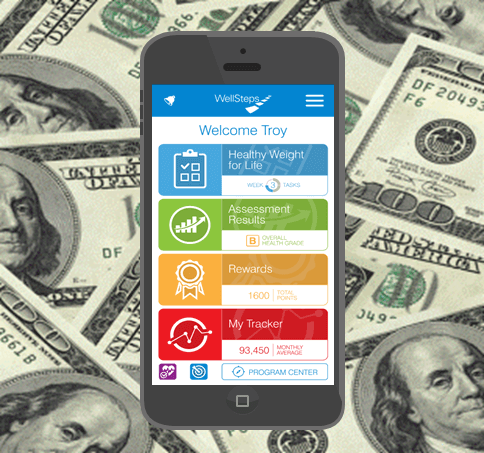Every effective wellness program should be using incentives. They are an important part in helping employees stay motivated to make long-term behavior change. But sometimes wellness incentive programs become THE wellness program. The wellness program management, or the tracking, awarding, and processing of the incentives, consumes the wellness budget and personnel time.

What are wellness incentives, anyway?
When we use the term “wellness incentives” in this article, we are referring to any kind of prize offered by a company to their employees as a reward for adopting healthy behaviors. Examples include: cash, gift cards, premium discounts, days off, wellness swag, etc. In an effective wellness program, these incentives are simply a tool. Albeit an important tool used to encourage people to make healthy decisions; the ultimate goal should be for employees to feel the benefits of their healthy behaviors and no longer need the incentive.
Here’s what an employee had to say at the end of the company’s first year of their program:
“I started out for the reward incentive, but, must admit, I learned a lot. I shared a lot of the information with my family; the [educational materials] were great!”
This is a great example of a company that used incentives as a tool to nudge employees toward small changes in behavior. However, for employees to reach the point of realizing that the benefits of their healthy behaviors far outweigh the incentives, the wellness program must be structured correctly. This takes more than just the incentives themselves!
What should a wellness program include, in addition to incentives?
Too many wellness programs are not really wellness programs at all. They are employee wellness incentive programs. This narrow focus on incentives means that much of the meat and potatoes of effective wellness programs has been completely abandoned.
The challenge is how to administer and manage an effective wellness program that does not consume too much time and resources. The nation’s best wellness programs are able to find a balance between the requirements needed to deliver an incentive program and the need to help employees improve their health. Here are 10 ways they do wellness incentive management:
1) They pick the right wellness incentives
The goal of the wellness program is to help employees adopt and maintain healthy behaviors. It is best when employees are internally motivated to be healthy.
However, sometimes employees get stuck in unhealthy habits and they need help adopting and maintaining healthy behaviors. The best way to do this is to provide small incentives such as gift cards. Provide incentives to randomly selected employees who successfully complete different aspects of a wellness program.
Employees can qualify for a drawing if they complete program elements. For example, a personal health assessment, biometric screening, a behavior change campaign, or a challenge. Every employee does not get an incentive for completing the target behavior because that leads to entitlement.

Instead, they earn the chance to win—sort of like the lottery, only not as big. Just having a chance to win is fun and is sufficient to motivate most employees.
For example, if 350 out of 500 employees at a given company complete a behavior change campaign, all 350 employees are entered to win a small number of gift cards, prizes, or event tickets. These small gifts given immediately upon program completion make the program more fun, create the opportunity for vicarious reinforcement, and provide substantial motivation at very little cost.
Even Better Options
Employers get even greater adoption of employee health behavior with a benefits-based incentive plan. Benefits-based wellness incentive programs typically offer employees a discount on their insurance premium. They may also offer paid time off, a contribution to an HSA or HRA, or a lower co-pay or deductible. This is a great wellness incentive management strategy.
Benefits-based incentives are considerably more expensive than randomly selecting winners of small gifts, but they also have more impact on employee engagement. Benefits-based incentives are made available to all employees who do the work to earn the reward. Many WellSteps clients offer a $50/month health insurance premium discount. This adds up to $600 per year per qualifying employee.
The dollar amount of the benefit-based incentives should be large enough to motivate employees, but not so much that it creates an entitlement mentality among program participants. Benefits-based incentive requirements should be substantial because the financial incentive should also be meaningful.
We have noted over the past 14 years that a premium differential incentive in the range of $30-$40 per month is optimal for achieving best outcomes. When combined with simple, short-term prizes, benefits-based incentives will provide employees with enough motivation to get the wellness ball rolling until they begin to feel the internal benefits of a healthy lifestyle.

One of the best ways to make sure you’re picking the right incentives is to ask your wellness committee for input. If your wellness committee is composed of a good cross section of employees they will provide valuable input on what a meaningful health incentive program would be for your employees.
Here are some time-tested employee incentive resources and ideas:
- Use incentives, but don’t make a big deal of them. Make a big deal out of the benefits.
- Make sure your employees know what all the benefits are. Give them a “What’s in it for me?” list.
- Never use punishments.
- Use both immediate incentives and larger benefits-based rewards
- Keep the law. Use the WellSteps Compliance Checker to make sure your incentive ideas are compliant with the law.
2) The wellness committee decides which behaviors, activities, or health status to incentivize
For better wellness incentive management, sit down with your wellness committee and come up with a list of behaviors, activities, or health risk levels that you’d like to see your employees accomplish. If this is the first year you are doing this you want to start small. Make it easy.
During the next few years you can change the different items you want to incentivize. Start small so that everybody has a chance to earn an incentive and, with time, help them make bigger improvements in their health.
You may have heard of incentive programs that are outcomes-based. The phrase “outcomes-based wellness program” may be confusing. When people use the phrase “outcomes-based wellness program,” what they mean is that the wellness incentive program is based on employees attaining a specific health outcome, such as not smoking or attaining certain results on biometric screenings.
Outcomes-based incentive programs are also known as health contingent wellness programs. There are many ways to set up an outcomes-based incentive program. Done correctly, they will help employees improve their health. However, when they are done incorrectly, they can do great harm to employee morale and trust.

Here is a simple incentive program for employees that could be used by any worksite. It is outcomes-based because it gives points for achieving a certain health status. The best part about this sample strategy is that it includes health risk status, health behaviors and wellness program participation.
100 Points Needed To Earn The Incentive
Have no elevated health risks (BP, CHOL, GLU, BMI, tobacco use) Participate in behavior change campaign #1 Participate in behavior change campaign #2 Complete preventive cancer screening Attend behavior change webinar/presentation #1 Attend behavior change webinar/presentation #2 Exercise 4 times a month for 6 months Meet with physician to discuss elevated health risk Track your activity with a wearable device Complete a smoking cessation program Complete an approved alternate activity | Points 70 20 20 20 20 20 20 20 20 50 20 |
3) The wellness committee assigns values to each item
Wellness incentive management should always adhere to the rule, “simpler is always better.” It is tempting to create elaborate point systems that can be used to track progress towards the incentives. Resist this urge and keep it simple.
Make a list of all of the different things you want your employees to do to earn an incentive. Rank this list from the most important to the least important. Then, using a point basis of 100 or 1000 points, assign the number of points you want to award for each activity.
Give the most points to the things that are most important and the least points to the ones that are least important. Just make sure that you give your employees lots of opportunities to qualify for the incentive, depending upon which activities they complete.
You can further divide your point system into different levels such as bronze, silver, and gold, with each one requiring a certain level of points. It doesn’t matter whether you use hundred points or thousand points. What’s important is the weight you assign to different activities.
It’s also nice if you can create enough flexibility in your system to allow employees to get the maximum incentive with multiple combinations of activities. Greater flexibility gives employees greater choice and that makes them happy.
4) The wellness committee determines which items can and cannot be verified
Another piece of wellness incentive management is considering verification for activities. With your list of activities ranked from most important to least important, you can now identify those that can be verified. Obviously if you’re going to provide a lot of money or large incentive for a certain activity, it’s preferable that the activity be verifiable.

But you should tread carefully when deciding which activities need to be verified. Here’s an example of why:
WellSteps was asked if we would help a large hospital system with their incentive program. They wanted to provide a meaningful incentive for those employees who were not tobacco users. Tobacco use can be verified, but that does not mean it should be. This hospital system wanted to verify every employee who claimed to be a non-smoker.
Their plan was to swab the inside of each employee’s mouth to get a sample of saliva. From the saliva, it is easy to determine who is and who is not a tobacco user. This is a very accurate way to determine who is using tobacco. It is also a very accurate way to determine who is lying.
The Catch
Unfortunately, you would have to test just about everyone to find a very small number of employees who were lying about their tobacco use. If the goal was to completely destroy employee morale and make it clear to employees that there is a lack of trust, then by all means, continue with the testing. But if the goal is to create a work environment of mutual trust and respect, then verifying wellness points by testing saliva is probably not a good idea.
Obviously, things such as blood work, preventative screenings, flu shots, completion of behavior change tasks, completion of wellness challenges and campaigns will need to be verified. If you have a good wellness incentive management platform all of these can be verified automatically with little to no work from you or your employees.
A good wellness incentive management platform will intuitively know who has completed which aspects of the program. Activities that are done offline such as a lunch and learn or a 5K race can also be verified, but may take some extra work.
The best incentive systems use a mixture of verifiable and non-verifiable activities. It’s easy to determine who has completed a health risk appraisal but it’s not so easy to verify self-reported health behaviors. And there’s nothing wrong with this.
Use your wellness incentive management platform to verify the important things and let employees self-report the rest. Provide more points for those that are validated and fewer points for those that are not.
5) Effective wellness programs make it easy for employees to verify and remind them to do so
Effective communication will make your wellness incentive program a lot easier for everyone. The best wellness programs use a variety of communication methods to remind employees to report their progress, provide verification, and adhere to program deadlines. A good incentive management system will do this automatically.

As has been noted in the previous section, employers sometimes require their employees to provide verification that an activity has been completed. But, today almost every single employee now has a smart phone. To make the verification process simple, the WellSteps app allows employees to take a picture of the verification form. The app will then have it automatically uploaded to their account. Once it has been uploaded the account manager can view the proof and award the necessary points.
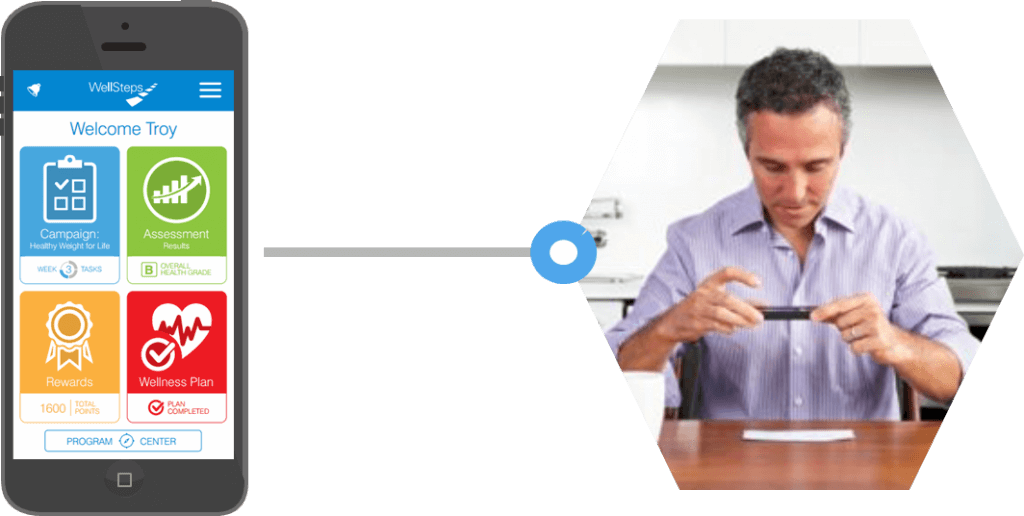
6) They make it easy for employees to view and update points
If it is not very easy for employees to report, view, and update their points, they won’t do it. Despite the good intentions of your wellness incentive program, if it’s a hassle to participate and get incentive points, employees won’t engage and your program will have no effect on employee health and productivity.
Here is an actual example of an incentive reporting spreadsheet that one employer was using. It looks very complicated and most employees won’t report their points, just because they can’t stand the spreadsheet. It reminds them of doing their taxes.
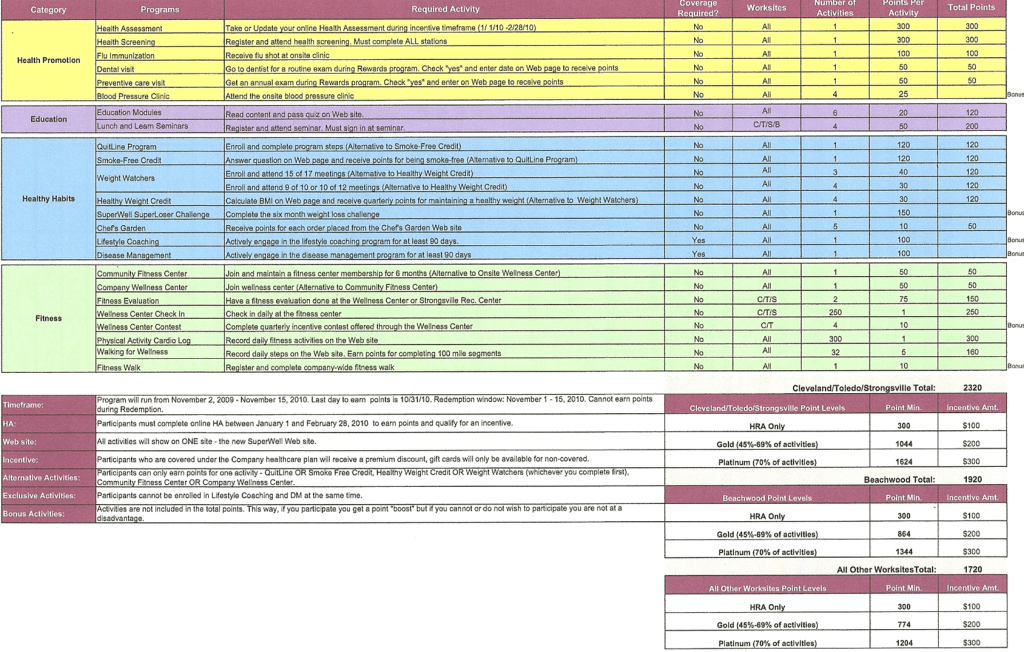
Instead of a complicated Excel spreadsheet it’s much more enjoyable to use a web-based design:
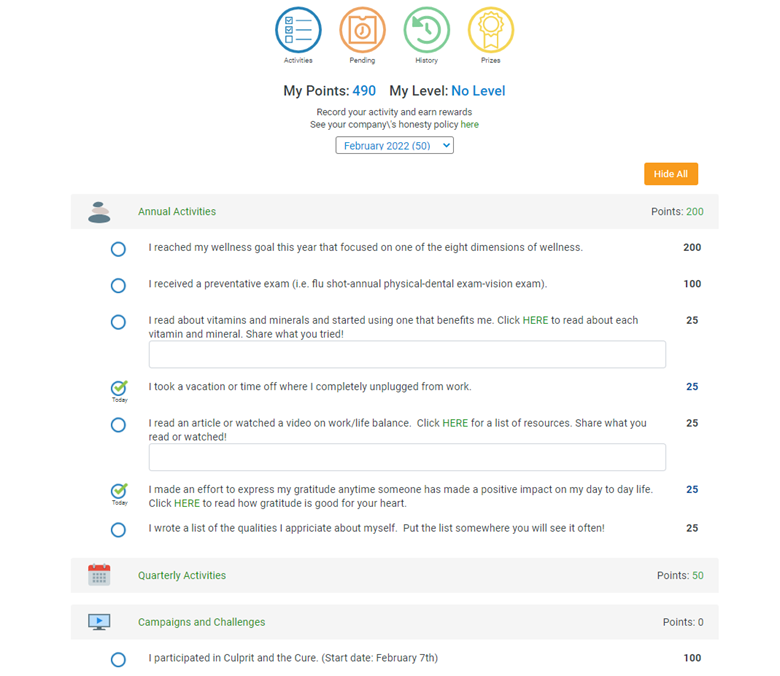
Making It Easy
Employees are constantly checking the status of their points just like they are constantly checking the number of steps reported on their wearable device. If you have a benefits-based incentive, employees will be constantly checking to make sure they have done everything they need to earn the incentive.
In other words, a good wellness incentive management platform will keep employees constantly informed of their point status and incentive progress. Without such a platform, every employee will continually be asking wellness coordinators if their paperwork has been received, if things have been verified, if they have the necessary points, if they qualify, etc..
In conclusion, without the type of communication provided by a simple web-based wellness incentive program, the hassle factor for the wellness coordinator can be tremendous. Below is an example of a wellness incentive management system that updates employee’s data in real time. It is an incentive dashboard that they can check 24 /7, using any web-enabled device:

7) They automatically determine who has earned the different incentives
Every time your employees complete a wellness challenge or campaign, a wellness coordinator will have to create a database of everybody who has completed it and randomly select some winners of the incentive. Then, at the end of the year, the same process will have to be used to determine who has earned the benefits-based incentive.
In today’s fast-paced world employees are, in truth, not as patient as they used to be. And, they’re usually not too thrilled to find out that they have to wait several weeks or months to determine if they have earned enough points to qualify for the wellness incentive.
Effective wellness programs use incentive management systems that allow everybody to get a status update in real time. Determining who has earned different incentives is done automatically and a full report and database is generated.
8) They purchase and distribute incentives
One of the most time and labor intensive aspects of a health and wellness incentive program is the purchasing and distribution of the incentives. Depending upon the incentives that are chosen, a wellness coordinator will have to purchase and distribute the correct incentives to the correct employees and make sure that the benefits department has the required data to determine who has earned the benefits-based incentive.
Incentives can be distributed electronically or physically through the mail or interoffice mail. They could even be handed out in person.
9) They handle appeals, problems, and unanticipated issues
Despite careful planning and the use of technology there will be some hiccups in the management of every wellness incentive program. There may be some unhappy employees who wish to appeal the reward decision. There will need to be a process in place to adjudicate these cases and do so in a fair and impartial manner that supports the overall goals and objectives of the wellness program.
Sometimes the incentives that were purchased and mailed are not received. Sometimes lost incentives have to be tracked down or resent. When these issues arise, it’s always helpful to have a robust, clean database of everything that has happened in your wellness incentive program.

10) They produce year-end accounting and participation reports
Most organizations want a summary of what happened with the incentive plan. This could include results from specific wellness programs and year-end results. In fact, there are many organizations that spend weeks producing these summary reports. It’s a shame that wellness coordinators and wellness professionals are sometimes spending an inordinate amount of time as wellness accountants.
Rather than coach the unhealthy or develop behavior change programs or lead exercise classes, they are pouring over reams of paper and spreadsheets to manually calculate and determine point awards and incentive tallies.
Then they spend more time creating charts and graphs that summarize the results of the program. But, the best wellness companies don’t do it this way. They use a wellness incentive management platform to show that they have an effective wellness program.
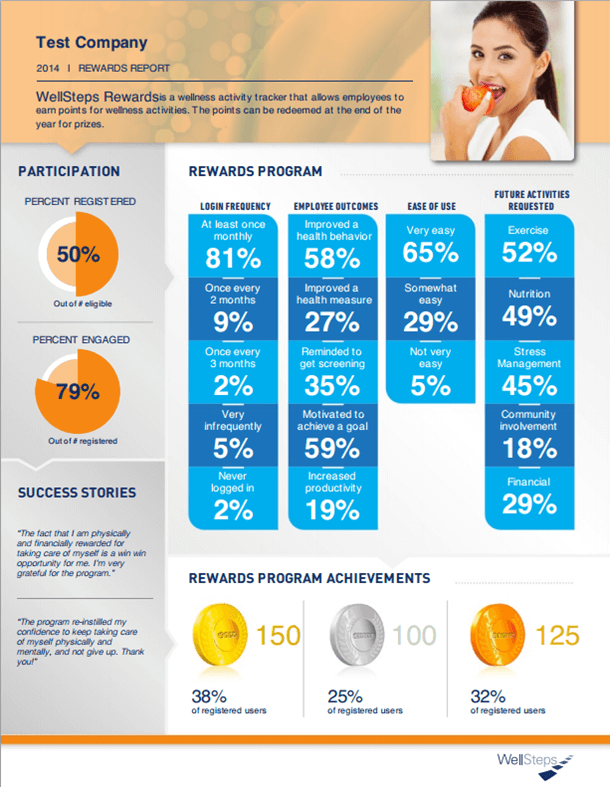
So What?
To summarize, technology has changed the way we track and administer incentives. Effective wellness programs use this new technology. For as little as 50 cents per month, employers can administer a employee wellness incentive program with ease. With a wellness incentive management system, wellness coordinators are free to do what they do best—improve the lives of those they serve.
Make incentives easy with the WellSteps Incentive Management platform, Schedule a FREE demo today.
What are some additional wellness incentive ideas?
Examples include:
- Paid time off
- Casual Friday
- Healthy snacks in the breakroom
- Onsite exercise classes
- Gym/fitness class membership
- Goodie bag from a healthy grocery store or restaurant
- Fitness attire
- Fitness equipment
- Company swag
- Paid entrance fees to athletic events (i.e. 5k, triathlon, etc.)
